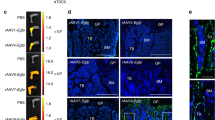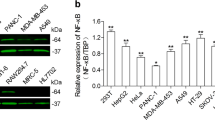Abstract
Although previous studies modified two components of conditionally replicating adenoviruses (CRAs), which selectively replicate in and kill cancer cells, the most accurate ways to achieve increased cancer specificity (that is, safety) without reducing the anticancer (that is, therapeutic) effects are unknown. Here, we generated two types of survivin-responsive m-CRAs (Surv.m-CRAs), Surv.m-CRA-CMVp and Surv.m-CRA-OCp, which use two and three different mechanisms to target cancer, that is, early region 1A (E1A) regulated by the survivin promoter and mutated E1BΔ55K regulated by the ubiquitously active cytomegalovirus promoter and cancer/tissue-specific osteocalcin promoter, respectively, and carefully examined their safety and anticancer effects. Endogenous osteocalcin mRNA was expressed and further enhanced by vitamin D3 in all osteosarcoma and prostate cancer cell lines and human osteoblasts, but not in human fibroblasts. The osteocalcin promoter activity was weak even with vitamin D3 treatment in these osteocalcin-expressing cancers, leading to low E1BΔ55K expression after Surv.m-CRA-OCp infection. Nevertheless, Surv.m-CRA-OCp had significantly increased cancer specificity without reduced anticancer effects in both in vitro and in vivo experiments. The unexpected but favorable fact that strong activity of an altered E1B promoter is unnecessary indicates that the majority of cancer/tissue-specific promoters may be used to generate ideal m-CRAs and will advance the development of m-CRA-based cancer therapies.
This is a preview of subscription content, access via your institution
Access options
Subscribe to this journal
Receive 12 print issues and online access
$259.00 per year
only $21.58 per issue
Buy this article
- Purchase on Springer Link
- Instant access to full article PDF
Prices may be subject to local taxes which are calculated during checkout






Similar content being viewed by others
References
Jounaidi Y, Doloff JC, Waxman DJ . Conditionally replicating adenoviruses for cancer treatment. Curr Cancer Drug Targets 2007; 7: 285–301.
Kelly E, Russell SJ . History of oncolytic viruses: genesis to genetic engineering. Mol Ther 2007; 15: 651–659.
Alemany R . Designing adenoviral vectors for tumor-specific targeting. Methods Mol Biol 2009; 542: 57–74.
Fueyo J, Gomez-Manzano C, Alemany R, Lee PS, McDonnell TJ, Mitlianga P et al. A mutant oncolytic adenovirus targeting the Rb pathway produces anti-glioma effect in vivo. Oncogene 2000; 19: 2–12.
Bischoff JR, Kirn DH, Williams A, Heise C, Horn S, Muna M et al. An adenovirus mutant that replicates selectively in p53-deficient human tumor cells. Science 1996; 274: 373–376.
Heise C, Hermiston T, Johnson L, Brooks G, Sampson-Johannes A, Williams A et al. An adenovirus E1A mutant that demonstrates potent and selective systemic anti-tumoral efficacy. Nat Med 2000; 6: 1134–1139.
Kamizono J, Nagano S, Murofushi Y, Komiya S, Fujiwara H, Matsuishi T et al. Survivin-responsive conditionally replicating adenovirus exhibits cancer-specific and efficient viral replication. Cancer Res 2005; 65: 5284–5291.
Nagano S, Oshika H, Fujiwara H, Komiya S, Kosai K . An efficient construction of conditionally replicating adenoviruses that target tumor cells with multiple factors. Gene Ther 2005; 12: 1385–1393.
Zhang Q, Chen G, Peng L, Wang X, Yang Y, Liu C et al. Increased safety with preserved antitumoral efficacy on hepatocellular carcinoma with dual-regulated oncolytic adenovirus. Clin Cancer Res 2006; 12: 6523–6531.
Li Y, Idamakanti N, Arroyo T, Thorne S, Reid T, Nichols S et al. Dual promoter-controlled oncolytic adenovirus CG5757 has strong tumor selectivity and significant antitumor efficacy in preclinical models. Clin Cancer Res 2005; 11: 8845–8855.
Altieri DC . The molecular basis and potential role of survivin in cancer diagnosis and therapy. Trends Mol Med 2001; 7: 542–547.
Ambrosini G, Adida C, Altieri DC . A novel anti-apoptosis gene, survivin, expressed in cancer and lymphoma. Nat Med 1997; 3: 917–921.
Murofushi Y, Nagano S, Kamizono J, Takahashi T, Fujiwara H, Komiya S et al. Cell cycle-specific changes in hTERT promoter activity in normal and cancerous cells in adenoviral gene therapy: a promising implication of telomerase-dependent targeted cancer gene therapy. Int J Oncol 2006; 29: 681–688.
Takahashi T, Kawai T, Ushikoshi H, Nagano S, Oshika H, Inoue M et al. Identification and isolation of embryonic stem cell-derived target cells by adenoviral conditional targeting. Mol Ther 2006; 14: 673–683.
Terazaki Y, Yano S, Yuge K, Nagano S, Fukunaga M, Guo ZS et al. An optimal therapeutic expression level is crucial for suicide gene therapy for hepatic metastatic cancer in mice. Hepatology 2003; 37: 155–163.
Yeung F, Law WK, Yeh CH, Westendorf JJ, Zhang Y, Wang R et al. Regulation of human osteocalcin promoter in hormone-independent human prostate cancer cells. J Biol Chem 2002; 277: 2468–2476.
Sneddon WB, Demay MB . Characterization of an enhancer required for 1,25-dihydroxyvitamin D3-dependent transactivation of the rat osteocalcin gene. J Cell Biochem 1999; 73: 400–407.
Fanburg-Smith JC, Bratthauer GL, Miettinen M . Osteocalcin and osteonectin immunoreactivity in extraskeletal osteosarcoma: a study of 28 cases. Hum Pathol 1999; 30: 32–38.
Yuge K, Takahashi T, Nagano S, Terazaki Y, Murofushi Y, Ushikoshi H et al. Adenoviral gene transduction of hepatocyte growth factor elicits inhibitory effects for hepatoma. Int J Oncol 2005; 27: 77–85.
Nagano S, Yuge K, Fukunaga M, Terazaki Y, Fujiwara H, Komiya S et al. Gene therapy eradicating distant disseminated micro-metastases by optimal cytokine expression in the primary lesion only: novel concepts for successful cytokine gene therapy. Int J Oncol 2004; 24: 549–558.
Kawai T, Takahashi T, Esaki M, Ushikoshi H, Nagano S, Fujiwara H et al. Efficient cardiomyogenic differentiation of embryonic stem cell by fibroblast growth factor 2 and bone morphogenetic protein 2. Circ J 2004; 68: 691–702.
Ushikoshi H, Takahashi T, Chen X, Khai NC, Esaki M, Goto K et al. Local overexpression of HB-EGF exacerbates remodeling following myocardial infarction by activating noncardiomyocytes. Lab Invest 2005; 85: 862–873.
Mizuguchi H, Kay MA . Efficient construction of a recombinant adenovirus vector by an improved in vitro ligation method. Hum Gene Ther 1998; 9: 2577–2583.
Guo ZS, Wang LH, Eisensmith RC, Woo SL . Evaluation of promoter strength for hepatic gene expression in vivo following adenovirus-mediated gene transfer. Gene Ther 1996; 3: 802–810.
Osaka E, Suzuki T, Osaka S, Yoshida Y, Sugita H, Asami S et al. Survivin expression levels as independent predictors of survival for osteosarcoma patients. J Orthop Res 2007; 25: 116–121.
Zhang JF, Wei F, Wang HP, Li HM, Qiu W, Ren PK et al. Potent anti-tumor activity of telomerase-dependent and HSV-TK armed oncolytic adenovirus for non-small cell lung cancer in vitro and in vivo. J Exp Clin Cancer Res 2010; 29: 52.
Ahn BC, Ronald JA, Kim YI, Katzenberg R, Singh A, Paulmurugan R et al. Potent, tumor-specific gene expression in an orthotopic hepatoma rat model using a Survivin-targeted, amplifiable adenoviral vector. Gene Ther 2011; 18: 606–612.
White E, Denton A, Stillman B . Role of the adenovirus E1B 19 000-dalton tumor antigen in regulating early gene expression. J Virol 1988; 62: 3445–3454.
White E . Regulation of the cell cycle and apoptosis by the oncogenes of adenovirus. Oncogene 2001; 20: 7836–7846.
Chang J, Zhao X, Wu X, Guo Y, Guo H, Cao J et al. A phase I study of KH901, a conditionally replicating granulocyte–macrophage colony-stimulating factor: armed oncolytic adenovirus for the treatment of head and neck cancers. Cancer Biol Ther 2009; 8: 676–682.
Nemunaitis J, Tong AW, Nemunaitis M, Senzer N, Phadke AP, Bedell C et al. A phase I study of telomerase-specific replication competent oncolytic adenovirus (telomelysin) for various solid tumors. Mol Ther 2010; 18: 429–434.
Messerschmitt PJ, Garcia RM, Abdul-Karim FW, Greenfield EM, Getty PJ . Osteosarcoma. J Am Acad Orthop Surg 2009; 17: 515–527.
Acknowledgements
We thank S Yamashita for technical assistance. This work was supported by a grant for Promoting Business using Advanced Technology from the Japan Society and Technology Agency, and Health and Labor Science Research Grants for Third Term Comprehensive Control Research for Cancer from the Ministry of Health, Labour and Welfare of Japan.
Author information
Authors and Affiliations
Corresponding author
Ethics declarations
Competing interests
K Kosai is the founder of WyK BiotechPharma Inc., but does not earn a salary from the company. No other potential conflict of interest was disclosed.
Rights and permissions
About this article
Cite this article
Horikawa, Y., Wang, Y., Nagano, S. et al. Assessment of an altered E1B promoter on the specificity and potency of triple-regulated conditionally replicating adenoviruses: implications for the generation of ideal m-CRAs. Cancer Gene Ther 18, 724–733 (2011). https://doi.org/10.1038/cgt.2011.44
Received:
Revised:
Accepted:
Published:
Issue Date:
DOI: https://doi.org/10.1038/cgt.2011.44
Keywords
This article is cited by
-
A survivin-responsive, conditionally replicating adenovirus induces potent cytocidal effects in adult T-cell leukemia/lymphoma
BMC Cancer (2019)
-
Conditionally replicating adenovirus prevents pluripotent stem cell–derived teratoma by specifically eliminating undifferentiated cells
Molecular Therapy - Methods & Clinical Development (2015)
-
Survivin-responsive conditionally replicating adenovirus kills rhabdomyosarcoma stem cells more efficiently than their progeny
Journal of Translational Medicine (2014)
-
Oncolytic virotherapy for osteosarcoma using midkine promoter-regulated adenoviruses
Cancer Gene Therapy (2014)



